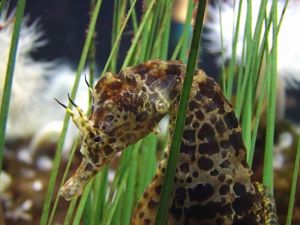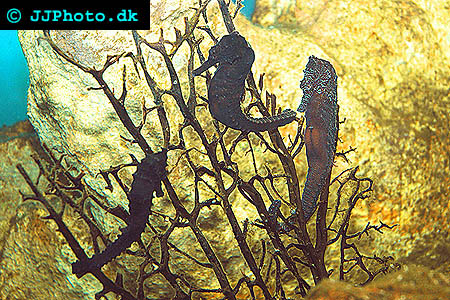Sea Horses in Aquariums

Keeping Sea horses
Seahorses in aquariums bring you a piece of deep-water wonder right into your living room. There was a time when people used to believe that sea horses were mythical creatures. Not any more. Being the most remarkable and the most magnificent creatures of the seas, they are actually quite normal fish. Their beautifully striking apparel and the sheer grace with which they carry themselves makes them stand apart.
Although there are about 35-40 species among sea horses, only a very few of them can be kept as ideal sea horses in aquarium. A giant seahorse can become as big as 14 inches, while there are small species that are only 1.5 inches in length. The seahorses in aquariums are usually kept in eelgrass or seaweed. This is their favored habitat in captivity. The striking contrast of their distinctive coloring against the bright green grass is an aquarist's dream come true.
It is easy to distinguish between the male and the female seahorses in an aquarium. The male seahorses have a small pouch just below their chest area. If you keep a male seahorse and a female seahorse in a tank, they will soon start the mating ritual. Mostly the seahorses take some rounds around the tank both in the mornings as well as the evenings. The couple holds each other or clasps each other by the end of their tails. They form a V like shape with their bodies and seem as if they are inspecting certain points within the tank. This is followed by the dance sequence. They circle each other for a few minutes. The male seahorse is usually very aggressive about the courtship behaviors. But the female easily gets distracted by food or other signs of movement nearby. In that case the male may "punish" the female by slightly nipping her head. This happens also if the female shows interest in another male. The seahorses are very stable in their relationships which even last for an entire lifetime. If there is only one male seahorse in an aquarium, he will change his partners as often as he desires. But, if there are a number of couples in the aquarium, it is observed that relationships last till either of the partner dies, after which a new partner is chosen. Sometimes the remaining partner dies of grief too.
In seahorses, pregnancy takes place in the male that later delivers the babies live. Not all the babies are ejected at once. Sometimes male seahorses in aquariums die after delivery because they may still be carrying dead babies within their bodies.

Sea horses of the species Hippocampus kuda. Copyright www.jjphoto.dk
The young seahorses are very small and need to be caught as soon as possible. Since they are so small, chances of their survival in the same tank is usually very remote. Sexual maturity occurs when the seahorses reach 6 months and the average life expectancy of seahorses in aquariums is about 4 years. Seahorses growing in aquariums become really very friendly and may try to grab the hand of the keeper. They eat out of the hand and show a propensity for grabbing on to objects not found in nature.
Seahorses in aquariums prefers eating live food even if they sometimes accepts pellets. They suck the shrimp into their snout. Immediately after the food is sucked in, the seahorse's head looks as if it is giving out steam. The seahorses in aquariums usually watch their prey for quite some time before they decide to eat it. Once they have chosen their prey, they chase it around in a very agile and aggressive manner. The tigertails are an attractive variety of seahorses that can be kept in aquariums. They stick their snouts into every crevice and hole waiting patiently for their food to come along. They also attach themselves on the back of other seahorses in the aquarium and rarely get shaken off.
Related Articles
Black Dogface Puffer - Information about Black Dogface Puffer
Bowfin fish - An introduction to living fossils know as Bowfin fish
Boxfish- Information about Boxfish
Crocodile needlefish - An introduction to Crocodile needlefish
Dogface puffer - Information about Dogface puffer
Hogfish - Information about Hogfish
Lionfish - An introduction to lionfish.
Mandarin Goby - An Introduction to the Mandarin goby
Marine Betta - Information about Marine Betta (Calloplesiops altivelis)
Moray eels- An article about how to keep moray eels in aquariums.
Nudibranch - An introduction to Nudibranchs
Octopus aquarium - How to keep and perhaps even breed Octupus in an aquarium.
Pipefish - An introduction to pipefish
Saltwater aquarium fish - An introduction to marine aquarium. fish for beginners.
Sea star facts - Intersting and fun acts about sea stars such as the fact that they are in no way related to fish.
Sea Stars - An introduction to Sea Stars.
Clownfish Articles:
Black Clownfish - Information about Black clown fish
Breeding Clownfish - A very brief describtion on how to breed clownfish
Percula Clownfish - An article about how to keep and breed Percula breeding.
Tomato Clownfish - An in deepth article about tomato clownfish
